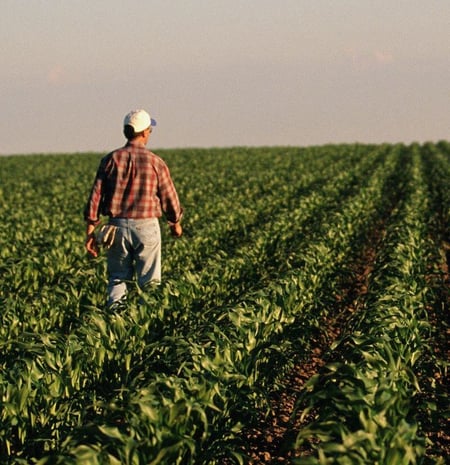
State of the Insurance Market:
2025 Outlook
Agriculture
Crop insurance remains a critical aspect of risk management for U.S. farmers. While natural disasters are commonly considered significant threats, evolving trade dynamics, international supply-demand shifts, and volatile weather patterns have underscored the need for comprehensive protection.
Rising input costs and narrow profit margins only amplify the necessity of robust crop insurance strategies to safeguard farm operations for future generations.
Market Conditions
The 2025 growing season brings both challenges and opportunities, as farmers face sustained pressure on profitability. High production costs persist, driven by expensive seed, fertilizer, and climbing land rents. Non-land expenses for crops like corn are projected at $750 per acre, with total costs exceeding $1,050 per acre in many regions. These rising costs, coupled with narrow profit margins and declining market prices, make the selection of effective risk management more critical than ever.
On the market side, commodity prices for 2025 are mixed. The projected price for corn sits at $4.70 per bushel, showing a slight increase from 2024, while soybeans are forecasted at $10.54 per bushel, significantly lower than the previous year. Narrowing price margins continue to pressure farmer profits, underscoring the role of crop insurance in providing stability amidst market fluctuations.
Revenue protection (RP) insurance remains a key tool, offering safeguards against production losses and revenue shortfalls. By guaranteeing a dollar amount per acre based on production history and commodity prices, RP ensures farms can weather unforeseen challenges, such as a volatile growing season or unexpected price drops.
Additionally, the enhanced coverage option (ECO) has garnered increased attention in 2025 thanks to a higher subsidy rate of 65%. This product provides revenue protection within a 95% to 86% coverage band with only a 5% deductible, allowing farmers to better manage small losses in pricing and yields. Subsidy adjustments have significantly reduced the cost of high-level coverage, making ECO a practical and attractive option for many producers. Additionally, a large suite of private products has given growers more choices and options for managing risk.
Coverage Considerations
Insurance premiums continue to decline into 2025 following reduced commodity prices. For instance, soybean-related premiums may see reductions due to lower price volatility, and corn policies reflect slightly higher guarantees for similar premium levels compared to 2024. This decline in costs provides farmers with the opportunity to expand their coverage portfolios without significantly increasing their insurance budgets.
The importance of a tailored approach cannot be overstated. Instead of selecting coverage based on premium costs, farmers should assess a range of factors, including production history, forward sales contracts, Farm Service Agency (FSA) programs, and county-specific trends. ECO and supplemental coverage option (SCO) products can be layered with RP policies to increase guarantees, particularly in high-risk scenarios.
To maximize efficiency, it’s critical for producers to evaluate how county-based triggers, historical performance trends, and past outcomes of insurance products align with their unique operational needs. Utilizing tools like profit matrices, decision calculators, and regional benchmarks can help farmers assess the value of their investments in both federal and private insurance products.
Specialty crop and livestock producers should also consider targeted insurance products. Products like livestock risk protection and dairy revenue protection continue to play a vital role for livestock farmers, while innovative solutions for crops such as apples, grapes, and vegetables remain essential components of effective risk management strategies.
Recommendations
Adopt a detailed, analytical approach to crop insurance decisions in 2025 to address ongoing financial pressures. A comprehensive strategy should include the following steps:
Assess costs and coverage needs: Start with a detailed analysis of production costs, expected yields, and contracted commodity sales. Use this data to determine the most appropriate insurance coverage.
Understand county vs. farm-level trends: Analyze how local county trends compare with individual farm performance to make data-driven decisions on coverage.
Consider advanced coverage options: Evaluate products like ECO alongside traditional RP policies to enhance your coverage. Focus on how increased subsidies can make top-level coverage more affordable.
Leverage decision tools: Use available calculators and risk evaluation tools to estimate premiums, guarantees, and potential payouts under different scenarios.
Evaluate specialty needs: For farms with unique risks (e.g., specialty crops or livestock), explore tailored policies that provide the specific coverage required.
Reflect on financial performance: Regularly assess financial health, focusing on whether input costs, market volatility, or production risks are affecting profitability. Ensure insurance strategies address these challenges effectively.
FSA programs: While not crop insurance, FSA programs need to be considered more strongly for 2025 due to higher yields. The interaction between crop insurance and government programs such as agriculture risk coverage (ARC) and SCO needs to be evaluated closely.


Connect with our
Agriculture Practice

The Risk Strategies Agriculture Practice incorporates the specialty expertise of Silveus Insurance Group, the largest independent crop insurance broker in the U.S.
To protect your agricultural investments and ensure the sustainability of your farming operations, obtaining the right crop insurance is essential. We’re specialists who help you determine what works best for your operation.
Download the Report
Our industry and product line specialists have collaborated to provide an update on current trends and market conditions.
We invite you to explore their insights by downloading our latest State of the Insurance Market Report.
Explore the Report
Industries
Insurance experts in our industry specialty practices work with our clients and are in the market placing insurance coverage every day. Review their outlook for your industry.
Business Solutions
The experts that support key business product lines across our organization are in the market placing insurance coverage every day. Take a look at their observations on the insurance landscape.
Explore More
Browse other areas within our State of the Insurance Market Report.
The contents of this report are for general informational purposes only and Risk Strategies Company makes no representation or warranty of any kind, express or implied, regarding the accuracy or completeness of any information contained herein. Any recommendations contained herein are intended to provide insight based on currently available information for consideration and should be vetted against applicable legal and business needs before application to a specific client.

